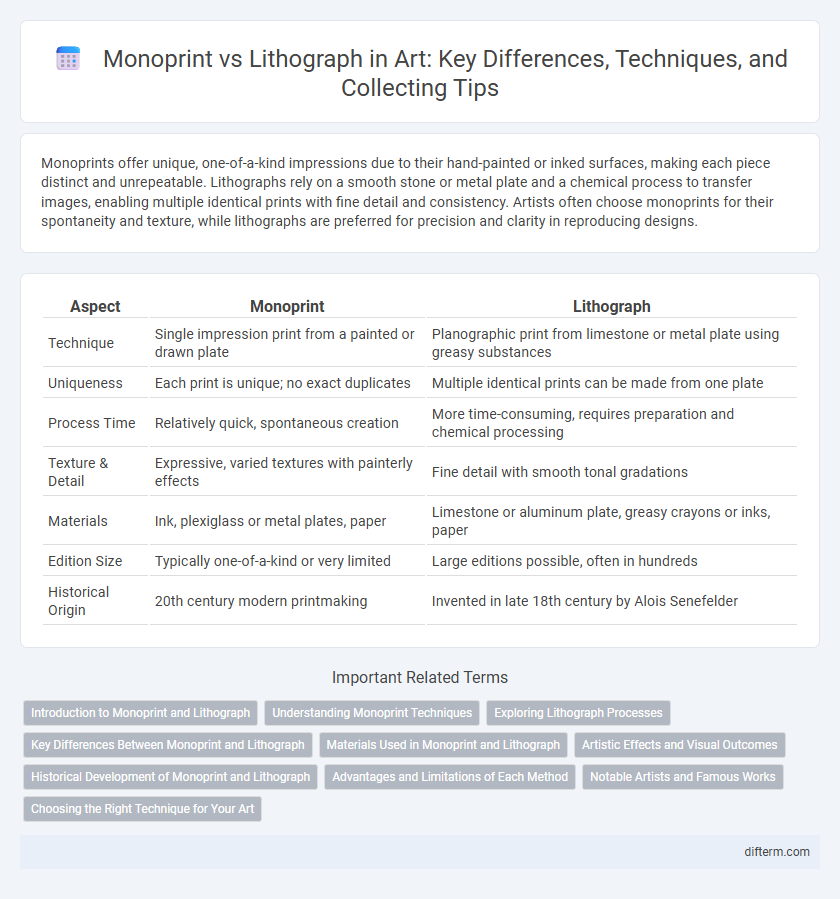Monoprints offer unique, one-of-a-kind impressions due to their hand-painted or inked surfaces, making each piece distinct and unrepeatable. Lithographs rely on a smooth stone or metal plate and a chemical process to transfer images, enabling multiple identical prints with fine detail and consistency. Artists often choose monoprints for their spontaneity and texture, while lithographs are preferred for precision and clarity in reproducing designs.
Table of Comparison
| Aspect | Monoprint | Lithograph |
|---|---|---|
| Technique | Single impression print from a painted or drawn plate | Planographic print from limestone or metal plate using greasy substances |
| Uniqueness | Each print is unique; no exact duplicates | Multiple identical prints can be made from one plate |
| Process Time | Relatively quick, spontaneous creation | More time-consuming, requires preparation and chemical processing |
| Texture & Detail | Expressive, varied textures with painterly effects | Fine detail with smooth tonal gradations |
| Materials | Ink, plexiglass or metal plates, paper | Limestone or aluminum plate, greasy crayons or inks, paper |
| Edition Size | Typically one-of-a-kind or very limited | Large editions possible, often in hundreds |
| Historical Origin | 20th century modern printmaking | Invented in late 18th century by Alois Senefelder |
Introduction to Monoprint and Lithograph
Monoprints are unique prints created by drawing or painting on a smooth surface, such as glass or metal, and then transferring the image onto paper, resulting in one-of-a-kind artworks with distinctive textures. Lithographs involve drawing on a flat limestone or metal plate with a greasy substance, exploiting the repellent properties of oil and water to produce multiple copies of the same image. Both techniques offer artists diverse creative possibilities, with monoprints emphasizing singular, spontaneous expressions and lithographs enabling precise, repeatable prints.
Understanding Monoprint Techniques
Monoprint techniques involve creating unique, one-of-a-kind prints by applying ink or paint to a smooth surface such as glass or metal, which is then pressed onto paper. Unlike lithographs, which rely on a limestone or metal plate and chemical processes to produce multiple identical copies, monoprints emphasize spontaneity and variation in texture, color, and form. Artists often experiment with layering and manipulation during the printing process to achieve distinct effects that cannot be exactly replicated.
Exploring Lithograph Processes
Lithography utilizes a flat stone or metal plate treated to repel ink except where the image is drawn with a grease-based medium, enabling high detail and tonal variation. Monoprints produce unique, one-of-a-kind prints by applying ink to a plate and pressing it onto paper, offering spontaneity but limited reproducibility. Exploring lithograph processes reveals intricate techniques like crayon drawing, chemical etching, and multi-color layering that allow artists to achieve precise textures and gradients unmatched in monoprint methods.
Key Differences Between Monoprint and Lithograph
Monoprint involves creating a one-of-a-kind print by painting or drawing directly onto a smooth surface, resulting in unique, textured images with varied ink application. Lithograph uses a flat stone or metal plate with a chemical process that repels ink on non-image areas, allowing multiple identical copies to be produced with consistent detail and shading. Key differences include monoprint's singular uniqueness versus lithograph's reproducibility, and the distinct techniques of direct manual application versus chemical-printing methods.
Materials Used in Monoprint and Lithograph
Monoprint involves materials such as a smooth, non-absorbent surface like glass or plexiglass, oil-based inks, and paper, allowing unique impressions with one-of-a-kind texture effects. Lithograph requires a flat limestone or metal plate treated with a grease-based medium, combined with water and oil-based lithographic ink to create multiple identical prints. The choice of materials directly impacts the tactile quality and reproducibility of the final artwork in both printmaking techniques.
Artistic Effects and Visual Outcomes
Monoprints offer unique, one-of-a-kind artistic effects characterized by rich textures and unpredictable color blending due to their single impression process. Lithographs produce consistent, finely detailed visuals with smooth gradations and crisp lines, ideal for replicating intricate drawings. The visual outcomes of monoprints emphasize spontaneity and organic variation, while lithographs focus on precision and clarity in image reproduction.
Historical Development of Monoprint and Lithograph
Monoprint emerged in the 17th century as artists explored unique, one-of-a-kind prints using a single plate, emphasizing spontaneity and individual expression. Lithography was invented in 1796 by Alois Senefelder, revolutionizing printmaking by enabling mass production through a planographic process on limestone. Both techniques significantly influenced art history by expanding possibilities for texture, reproduction, and artistic experimentation in the 18th and 19th centuries.
Advantages and Limitations of Each Method
Monoprint offers unique, one-of-a-kind images with spontaneous texture and tonal variation, ideal for artists seeking creative freedom, but it lacks reproducibility since each print is singular. Lithography enables consistent production of high-quality, detailed prints through a planographic process suitable for large editions, though it requires complex equipment and skilled labor, leading to higher costs. While monoprints emphasize expressiveness and originality, lithographs excel in precision and repeatability, shaping their distinct roles in fine art printmaking.
Notable Artists and Famous Works
Monoprint techniques are famously associated with artists like Edgar Degas, whose distinctive monoprints such as "Woman Bathing" showcase expressive textures and singular prints. Lithography gained prominence through artists like Henri de Toulouse-Lautrec, known for iconic lithographs including "Moulin Rouge: La Goulue," which highlight bold lines and vibrant colors. These notable artists and their celebrated works demonstrate the unique expressive possibilities and historical significance of monoprint and lithograph processes in the art world.
Choosing the Right Technique for Your Art
Monoprint offers unique, one-of-a-kind impressions with rich textures and spontaneous marks, ideal for artists seeking expressive and immediate results. Lithograph provides precise, repeatable images through chemically treated stone or metal plates, perfect for detailed compositions and multiple editions. Understanding the desired artistic effect and production scale helps determine whether monoprint's singularity or lithograph's reproducibility best suits your creative goals.
monoprint vs lithograph Infographic

 difterm.com
difterm.com